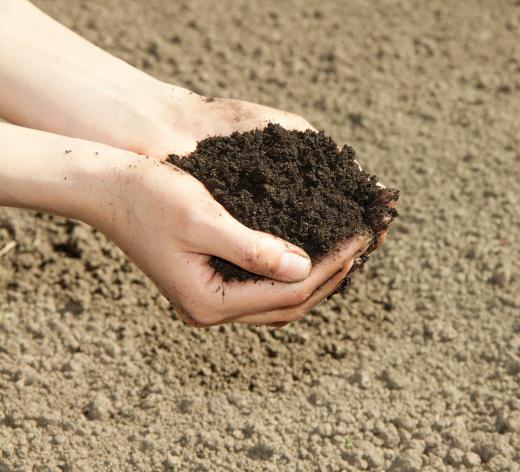What Is Soil Erosion?
Soil erosion is a natural process that occurs as soil is washed away by running water, blown away by wind, or removed by human activities such as tilling. This process is thought to be essential to the formation of new soil. Unfortunately, due to improper cultivation practices coupled with windstorms and excessive rainfall, erosion may accelerate. When this occurs, agricultural areas and the environment as a whole may be compromised. Complications of soil erosion can include a reduction of soil quality at the site of the erosion, and contaminated watercourses in other locations.
Natural soil erosion, also referred to as background or geological erosion, has played an important role in soil formation for at least 450 million years. Geological erosion consists of natural elements, such as water or ice, wind, or gravity, gradually wearing away rock formations to create soil. This slow process is said to remove soil at about the same rate as it is formed.

When soil is depleted more quickly than it is created, it is known as accelerated erosion. Unlike geological soil erosion, which is generally thought to be beneficial, accelerated erosion may have a detrimental effect on the environment and agriculture. This process is most often caused by human activities, such as over-cultivation by farmers and overgrazing by animals, irrigation, deforestation, and urbanization.

Two of the main problems of soil erosion are a decrease in soil quality and an increase of watercourse contamination. The upper layers of soil are considered the most nutrient rich and are also thought to help retain water. When these layers become eroded, vegetation can become deprived of essential nutrients and moisture. Eroded soil may move to other locations, causing environmental complications. When this soil is relocated to watercourses, it can lead to a disruption in the ecosystems of lakes, sedimentation in dams, and pollutants in drinking water.

As soil erosion can negatively impact agriculture and the environment, soil conservation is considered essential. A number of methods can help prevent erosion. Some of the most frequently used ones include contour plowing, crop rotation, and terracing along slopes. In residential areas, one of the most common ways to control erosion consists of planting trees or flowers in the affected area. Other methods include covering the area with nutrient-rich mulch or fertilizer, and building small retaining walls around garden beds.
AS FEATURED ON:
AS FEATURED ON:













Discussion Comments
@rundocuri- First of all, I think that you need to give the soil a break from your annual corn crop. If you skip planting corn there for a few years, this will help. During the growing seasons that you don't plant corn there, planting a different crop will help to put back the nutrients that are depleted from the soil. Alfalfa, beans, peas, and potatoes are all good options that will benefit the soil.
You can also add a fertilizer to the soil along with your rotated crops. This will give it a boost, and benefit the plants that you put there in place of corn. After two or three years, you can give planting corn in the usual spot a try again. Don't forget that you can also plant your corn in another section of your garden while you rotate your crops.
I'm looking for some tips to rejuvenate some eroded soil on my property. I have a vegetable garden with a section that I set aside each year for corn. For the past several years, my corn crop has been terrible, so I assume that the soil has been eroded from years of planting the same crop there. What should I do to put the nutrients back into the soil so my corn will thrive?
Post your comments